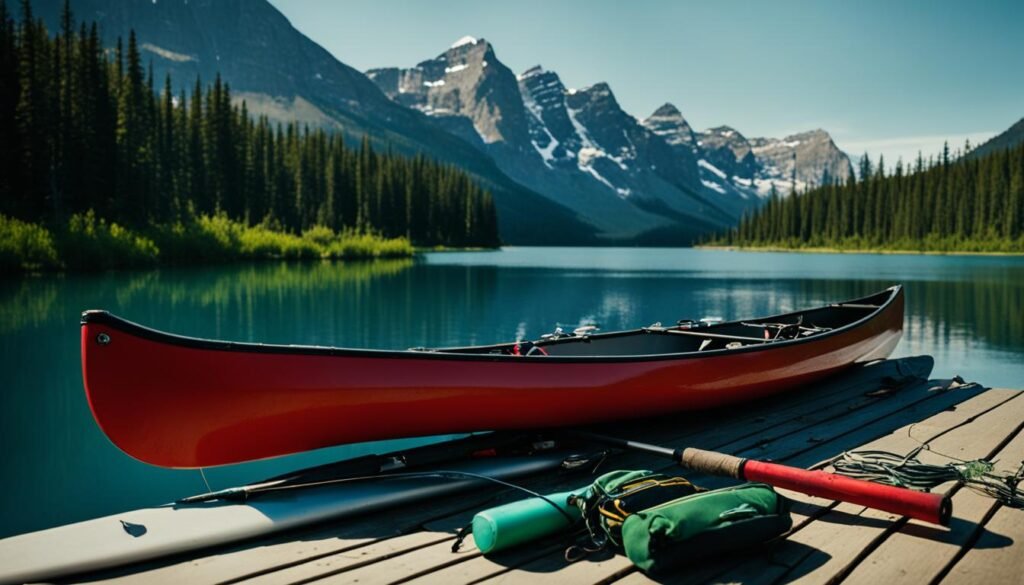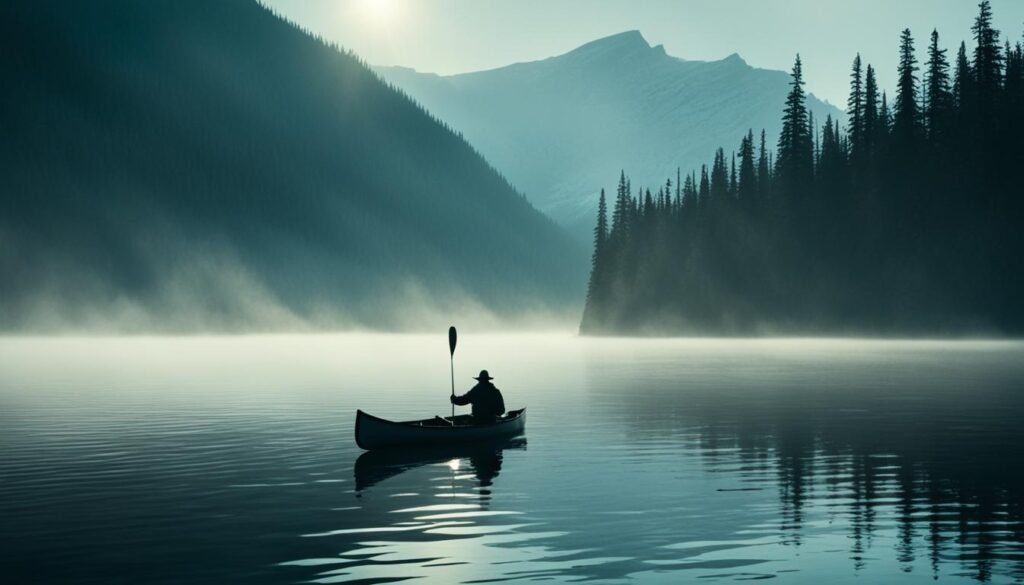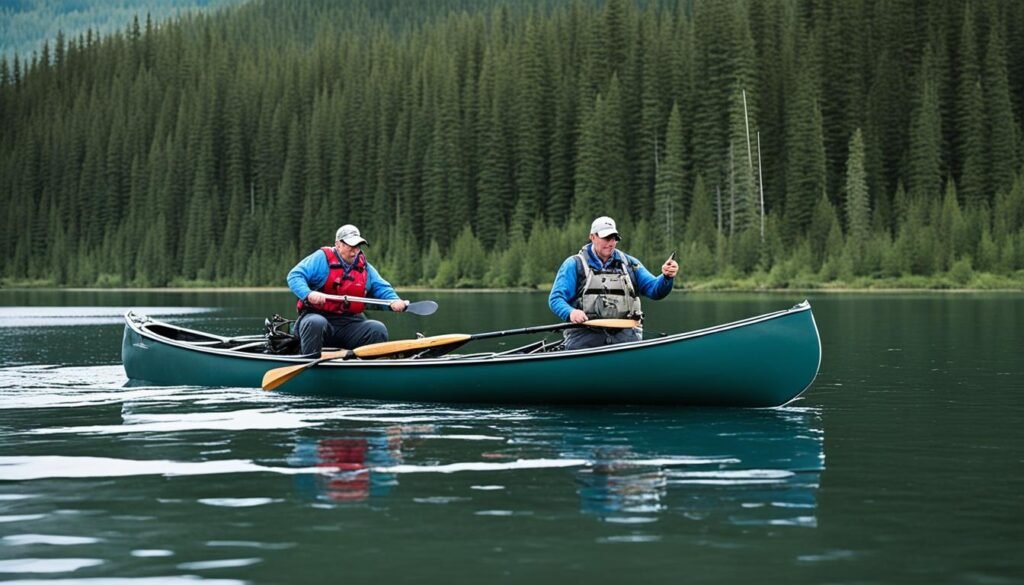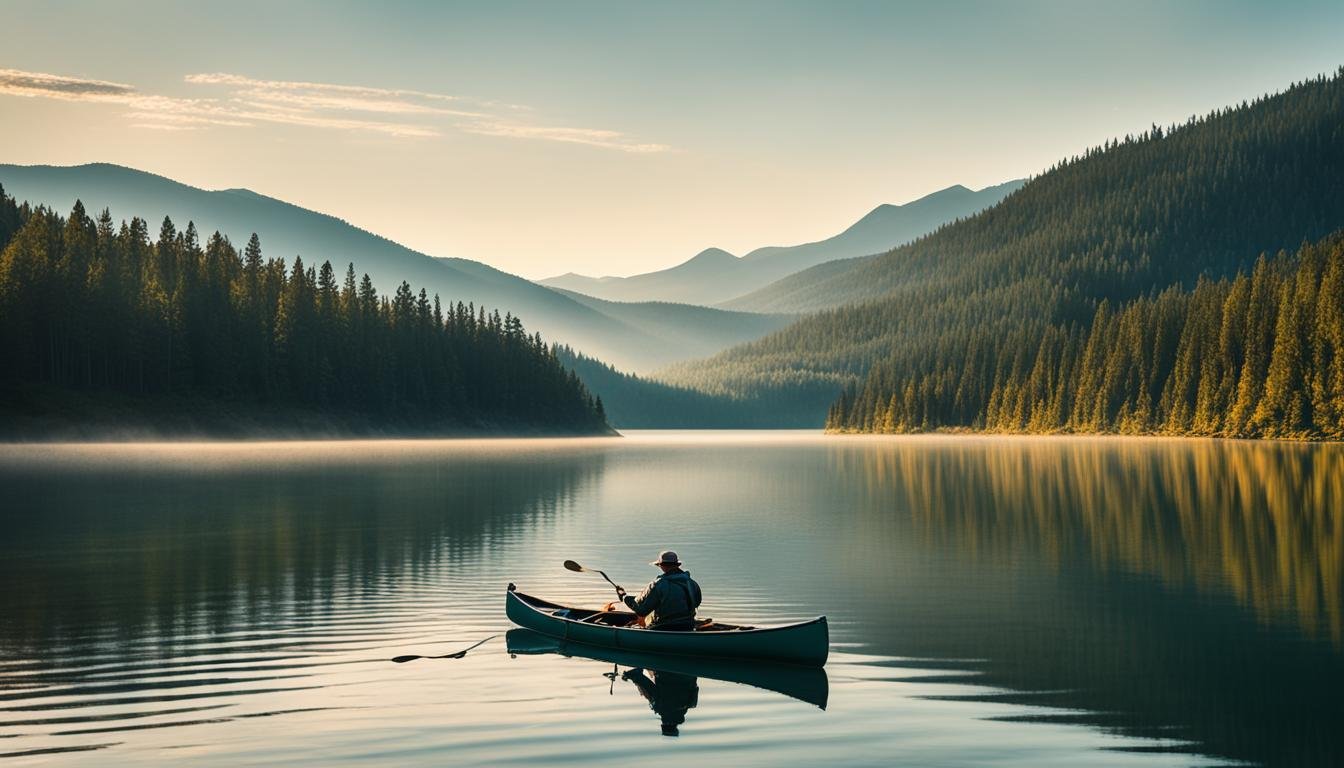Are you ready to unlock the secrets of fishing from a canoe in Canada’s vast wilderness?
Whether you’re an experienced angler or a novice, the art of canoe fishing techniques can elevate your outdoor adventures and provide a unique perspective on the sport. Imagine gliding silently across a pristine lake, casting your line with precision, and hooking into the catch of a lifetime – all from the comfort of your trusty canoe.
In this comprehensive guide, we’ll explore the allure of kayak angling, uncover the benefits of river fishing from a canoe, and delve into the nuances of fly fishing from a canoe.
Whether you’re seeking to master canoe paddling techniques for stillwater canoeing or unlock the secrets of canoe stability and canoe rigging for fishing, this article has got you covered.
Key Takeaways about Canoe Fishing Techniques
- Discover the art of canoe fishing techniques for a unique angling experience
- Explore the benefits of fishing from a canoe in Canada’s vast wilderness areas
- Learn essential tips and tricks for mastering canoe casting methods and navigation
- Understand the importance of canoe stability and rigging for successful fishing adventures
- Gain insights into the various fishing techniques and gear optimizations for canoe-based angling
Introduction to Canoe Fishing
Canoe fishing is a unique and captivating way to experience the great outdoors. The allure of fishing from a canoe lies in the silent approach, the ability to access remote wilderness areas, and the sheer joy of gliding across tranquil waters in search of the perfect catch. For anglers in Canada, this mode of fishing offers a truly remarkable and rewarding experience.
The Allure of Fishing from a Canoe
Canoeing and Canoe Fishing go hand-in-hand, as the silent propulsion of a canoe allows anglers to sneak up on wary fish without disturbing the water’s surface. This stealthy approach is a significant advantage, particularly when targeting skittish species like trout or bass. Additionally, the mobility of a canoe enables anglers to cover more ground, allowing them to explore a wider range of Canoeing for Fishing hotspots and uncover the most productive fishing locations.
Benefits of Canoe Fishing in Canadian Waters
Fishing from Canoes in Canada’s vast network of lakes, rivers, and streams provides anglers with a truly unique and rewarding experience. The country’s pristine wilderness offers an unparalleled backdrop for Canoe Angling Advantages, where anglers can immerse themselves in the natural beauty and serenity of the surroundings. Whether exploring the remote reaches of Wabakimi Provincial Park or drifting along the Boundary Waters Canoe Area Wilderness, Canadian Canoe Fishing promises an unforgettable adventure for anglers of all skill levels.
“Canoe fishing is the ultimate way to experience the wilderness and connect with the natural world. The silent approach and mobility of a canoe allow you to get closer to the fish and discover secret fishing spots that would otherwise be inaccessible.”
By embracing the unique opportunities that Canoe Fishing offers, anglers can unlock a world of adventure and fishing success in the stunning landscapes of Canada. Whether you’re a seasoned veteran or a newcomer to the sport, the allure of Canoeing for Fishing is sure to captivate your senses and leave a lasting impression.
Essential Gear for Canoe Fishing

Embarking on a canoe fishing adventure requires carefully selecting the right gear to ensure a safe and successful experience. From choosing the ideal canoe to packing the essential tackle and lures, every piece of equipment plays a vital role in your pursuit of freshwater and saltwater species.
Choosing the Right Canoe for Fishing
The foundation of your canoe fishing setup begins with the vessel itself. Opt for a stable, wide canoe designed specifically for fishing, rather than a sleek, narrow model focused on paddling efficiency. Look for features like built-in storage compartments, mounting points for accessories, and a spacious deck to accommodate your fishing gear and movement.
Essential Tackle and Lures
When it comes to Canoe Fishing Tackle, pack a minimalist yet versatile selection. Focus on lures that can catch a variety of fish species, such as Lures for Canoe Fishing like plastic grubs, jigs, and trolling Canoe Fishing Crankbaits. A three-way swivel rig is a must-have for trolling spoons and diving lures from the stability of your canoe.
Remember, the key is to travel light while still having the necessary Canoe Fishing Gear to target a variety of fish species in the Canadian Waters you’ll be exploring. With the right Fishing Canoe Selection and Canoe Fishing Tackle, you’ll be well-equipped to make the most of your time on the water.
Canoe Fishing Techniques

When it comes to Canoe Fishing Tactics, anglers need to employ specialized techniques to be successful in Canadian waters. One versatile method is jigging with plastic grubs, which can catch a variety of fish from walleye to bass and pike. For Fishing Lure Techniques from Canoe, trolling crankbaits allows you to cover more water and locate where the fish are holding.
When Canoe Angling Strategies involve drifting a canoe, using a vertical jigging presentation can be an effective way to target walleye in current. As you’re Finding Fish from Canoe, carefully scanning the water from your elevated vantage point in the canoe can help you locate underwater structure, current seams, and other fish-holding areas.
Luring Techniques for Various Fish Species
To target a wide range of fish in Canadian waters, anglers can employ two effective lure setups. Using heavy jig heads can be productive for catching lake trout, while moderate jig weights work well for pickerel (walleye). For bass and pike, light jigs are often the preferred choice.
When Fishing Lure Techniques from Canoe, a three-way swivel can be a valuable tool for trolling with spoons at varying depths without the need for a downrigger. This setup allows you to cover the water column and increase your chances of finding active fish.
Locating Hotspots from a Canoe
Scanning the water from the elevated vantage point of a canoe can be a game-changer when it comes to Finding Fish from Canoe. By carefully observing the water, you can identify valuable fish-holding areas, such as underwater structure, current seams, and other prime locations.
Additionally, utilizing an anchor made of a basketball net, rope, carabiner, and a rock can help you maintain your position and stability when fishing from a specific spot. A drift sock can also provide more stability and a more relaxed fishing experience while drifting along the water.
By mastering these Canoe Fishing Tactics and Canoe Angling Strategies, anglers can unlock the full potential of fishing from a canoe in the diverse and bountiful Canadian waters.
Landing and Handling Fish from a Canoe

Catching fish from a canoe presents unique challenges when it comes to landing and handling your catch. Proper techniques are essential to ensure the safety of both the angler and the fish, whether you plan to release or keep your haul.
When fishing with a partner, have them ready with a net to scoop up the fish as you work the rod. For solo anglers, a small landing net can be an invaluable tool. Gently guide the fish alongside the canoe, avoiding excessive handling that could damage the fish.
If you plan to keep the fish, use a fish club to quickly and humanely dispatch the catch before bringing it aboard. This minimizes thrashing that could potentially harm the canoe. For catch-and-release, handle the fish as little as possible, supporting its body and reviving it in the water before a gentle release.
Proper tools and techniques are crucial when landing and handling fish from a canoe. Nets with soft or rubber-dipped mesh are ideal for catch-and-release, while long-handled rubber nets work well for larger species. Plastic fish grippers and lip grippers help control the fish’s head, preventing it from dropping into the boat or onto the angler.
“The key is to minimize stress and handling for the fish,” explains avid canoe angler, Alex Wilson. “Treat every catch with care, whether you plan to keep it or let it go.”
By mastering the art of Canoe Fishing Landing Techniques and Handling Fish from Canoe, you can ensure a successful and responsible Canoe Angling Fish Management experience on the water.
Canoe Fishing Techniques: Tips for Canadian Waters

Trolling Crankbaits
Trolling crankbaits is a highly productive technique for canoe anglers in Canadian waters. By covering water and finding fish while traveling to your next campsite, you can maximize your time on the water. Experiment with chartreuse Berkley Flicker Minnows or similar lures, adjusting the amount of line you let out to get the lure down to the strike zone.
Canoe Drifting for Walleye
Drifting a jig and twister tail is an effective way to target walleye from a canoe, especially in current or windy conditions. Keep a tight, vertical line and feel for the bottom as the canoe drifts, allowing you to cover likely walleye hangouts with precision.
According to angler Stephen Molson, trolling quality stickbaits and crankbaits accounts for 90% of his canoe fishing tactics in Ontario’s Algonquin Provincial Park. Molson recommends packing two rods per person for backcountry trips, matching the lures’ diving depths to the targeted fish species and water conditions.
Molson’s canoe-trolling technique is adaptable for catching a variety of species, including northerns on deep weedlines, walleye in current areas and on rocky flats, and smallmouth bass in diverse locations. He emphasizes the importance of monitoring the rod tip to ensure the lure is running properly for successful fishing.
Fishing from a canoe or kayak provides a silent means to access areas and imparts a deadly action on any bait being trolled due to the craft’s movement across the water. This stealthy approach has proven effective for targeting night-feeding walleye, as well as provoking rod-jarring strikes from smallmouth bass in deep water.
Whether you’re Trolling from Canoe, Canoe Crankbait Fishing, or Drifting Canoe for Walleye, mastering these Canadian Canoe Fishing Tactics can be the key to unlocking the full potential of your backcountry fishing adventures.
Cooking Your Catch
After a successful day of canoe fishing, there’s nothing quite like enjoying your fresh catch right on the water. Shore lunch classics like fried fish, potatoes, and baked beans are a time-honored tradition for canoe fishing meal ideas. But for a change of pace, why not try making delicious fish tacos for canoe trips?
Shore Lunch Classics
The shore lunch is an integral part of the canoe fishing experience in Canada. This time-tested tradition involves frying up your just-caught fish over an open campfire, often accompanied by simple sides like roasted potatoes and baked beans. The key is to keep it simple and let the fresh, flavorful cooking fish from canoe shine.
To prepare a classic shore lunch, start by filleting your fish, such as walleye or pike, and seasoning them with a light dusting of flour, salt, and pepper. Heat up a cast-iron skillet over the fire and add a generous amount of oil. Fry the fish fillets until golden brown and crispy on both sides, then serve them hot with your favorite accompaniments.
Canoe Trip Fish Tacos
For a more creative take on canoe fishing meal ideas, consider making fish tacos for canoe trips. This portable and flavor-packed option is perfect for enjoying on the water. Start by cutting your freshly caught fish, such as walleye or pike, into bite-sized pieces. Coat them in a simple batter and fry them up until crispy.
Serve the fried fish pieces on warm tortillas, topped with a crunchy coleslaw and a drizzle of spicy mayo. You can also add diced avocado, fresh cilantro, and a squeeze of lime juice for a truly delicious and satisfying cooking fish from canoe experience.
Whether you opt for traditional shore lunch favorites or creative fish tacos for canoe trips, the key is to keep it simple and let the fresh, flavorful cooking fish from canoe be the star of the show. With a few basic ingredients and a campfire, you can enjoy a truly memorable meal on your next canoe fishing adventure.
Safety Considerations for Canoe Fishing
When it comes to canoe fishing, safety should be the top priority. Maintaining the stability and balance of your canoe is crucial, as it can significantly impact your ability to cast, land fish, and navigate the water safely. To ensure a secure and enjoyable fishing experience, it’s essential to pay close attention to Canoe Stability and Balance throughout your outing.
One of the most important safety measures is to always wear a properly fitted Canoe Fishing Safety life jacket. This simple yet effective precaution can mean the difference between a safe return and a tragic outcome, especially in the event of an unexpected capsizing or falling overboard. Additionally, staying aware of the weather conditions is vital, as strong winds, waves, and thunderstorms can quickly turn a peaceful fishing trip into a dangerous situation.
Proper paddling techniques and bracing the canoe are also crucial for Canoe Fishing Risk ManagementMastering these skills can help prevent capsizing, particularly in challenging conditions. It’s also essential to be mindful of potential hazards in the water, such as fallen trees, low-head dams, and strong currents, which can pose a severe threat to your safety.
| Safety Considerations | Importance | Recommended Actions |
|---|---|---|
| Canoe Stability and Balance | Ensures your safety and ability to fish effectively |
|
| Wearing a Life Jacket (PFD) | Can save your life in the event of an accident or capsize |
|
| Weather Awareness | Helps you anticipate and respond to changing conditions |
|
| Paddling Techniques and Bracing | Improves your ability to control the canoe and prevent capsizing |
|
| Awareness of Water Hazards | Helps you navigate safely and avoid dangerous situations |
|
By prioritizing Canoe Fishing Safety, maintaining Canoe Stability and Balance, and proactively managing Canoe Fishing Risk, you can ensure a safe and enjoyable fishing experience on the water. Remember, safety should always come first when embarking on your canoe fishing adventures.
Top Canoe Fishing Destinations in Canada
Canada’s vast wilderness offers a treasure trove of exceptional canoe fishing destinations. From the remote reaches of Wabakimi Provincial Park to the renowned Boundary Waters Canoe Area Wilderness, anglers can explore a diverse array of rivers, lakes, and rapids teeming with trophy fish.
Wabakimi Provincial Park
Nestled in Northern Ontario, Wabakimi Provincial Park is a true angler’s paradise. This remote wilderness boasts an expansive network of interconnected waterways, providing excellent opportunities to target pike, walleye, and lake trout from the comfort of a canoe. The park’s rivers, lakes, and rapids offer a thrilling and authentic canoeing experience, with the chance to encounter wildlife such as moose, bears, and beavers along the way.
Boundary Waters Canoe Area Wilderness
Spanning the border between Ontario and Minnesota, the Boundary Waters Canoe Area Wilderness is renowned for its exceptional fishing and paddling experiences. This vast, protected wilderness offers countless fishable waters teeming with smallmouth bass, northern pike, and a variety of other species. Canoe anglers can explore a labyrinth of interconnected lakes and rivers, setting up camp on remote, pristine shores and immersing themselves in the tranquility of the great outdoors.
| Destination | Key Fishing Species | Unique Features |
|---|---|---|
| Wabakimi Provincial Park | Pike, Walleye, Lake Trout | Vast network of rivers, lakes, and rapids; Remote wilderness setting |
| Boundary Waters Canoe Area Wilderness | Smallmouth Bass, Northern Pike | Interconnected lakes and rivers; Shared between Ontario and Minnesota |
Canada’s Best Canoe Fishing destinations, such as Wabakimi Fishing and Boundary Waters Canoe Angling, offer a unique and unforgettable experience for anglers seeking to explore Remote Canadian Fishing Destinations.
Tips for Beginners and Experienced Anglers
Whether you’re new to Canoe Fishing for Beginners or an experienced Advanced Canoe Angling Techniques enthusiast, there are always ways to improve your Canoe Fishing Skills. For those just starting out, the key is to focus on developing your canoe handling abilities, balance, and overall comfort on the water. Experienced anglers, on the other hand, should continually experiment with new lures, presentations, and methods to find what works best in the ever-changing conditions of Canada’s waterways.
Persistence, patience, and a willingness to learn are essential to success when fishing from a canoe. Here are some tips to help both beginners and seasoned anglers enhance their Canoe Fishing Skills:
- Beginners should prioritize mastering canoe control and stability before worrying about catching fish. Practice maneuvering the canoe in calm waters until you feel confident.
- Experienced anglers should continuously experiment with new lures, presentations, and techniques to stay ahead of the game. Don’t be afraid to try something different if your usual methods aren’t working.
- For both beginners and experts, staying focused and observant is crucial. Pay attention to the movements of fish, the wind, and the water conditions to adapt your approach accordingly.
- Invest in quality gear that suits your needs and skill level. From rods and reels to personal flotation devices, having the right equipment can make a significant difference in your success and comfort on the water.
- Develop a strong understanding of the local waterways and the target species’ behavior. This knowledge will help you identify the best fishing spots and tactics to employ.
Regardless of your experience level, the key to mastering Canoe Fishing Skills lies in a combination of practice, adaptability, and a willingness to learn. By embracing these principles, both beginner and experienced anglers can enhance their canoe fishing prowess and enjoy the unique thrill of this sport.
| Canoe Fishing for Beginners | Advanced Canoe Angling Techniques |
|---|---|
| Focus on canoe control and stability | Continuously experiment with new lures and presentations |
| Practice maneuvering in calm waters | Stay adaptable to changing water conditions |
| Invest in quality, beginner-friendly gear | Develop a deep understanding of local waterways and fish behavior |
| Develop observational skills to read the water | Embrace a willingness to learn and try new techniques |
“The key to mastering Canoe Fishing Skills is a combination of practice, adaptability, and a willingness to learn.”
Conclusion
Canoe fishing in Canada is a truly captivating and rewarding experience that offers anglers a unique connection with the great outdoors. By mastering the essential gear, techniques, and safety considerations, anglers can unlock the incredible potential of these remote wilderness waters and pursue their dream catches from the comfort of a trusty canoe.
From the trophy-sized pike that lurk in secluded bays to the hard-fighting walleye that patrol the depths, the fish of a lifetime await discovery by those willing to embrace the tranquility and challenge of canoe fishing. With the right approach, any angler can elevate their skills and enjoy the thrill of landing a prized catch while immersed in the serene beauty of Canada’s pristine waterways.
Whether you’re a seasoned canoe enthusiast or a newcomer to the sport, the world of canoe fishing in Canada holds endless opportunities for adventure and personal growth. By honing your techniques, respecting the environment, and prioritizing safety, you can embark on unforgettable fishing expeditions and create lasting memories that will keep you returning to these captivating waters time and time again.
FAQ about Canoe Fishing Techniques
What are the benefits of fishing from a canoe in Canadian waters?
Fishing from a canoe allows anglers to access remote wilderness areas, sneak up on wary fish, and cover more water to find productive hotspots. The silent approach and mobility of a canoe provide a unique and rewarding angling experience.
What gear is essential for successful canoe fishing?
Choose a stable, wide canoe designed for fishing, not just paddling efficiency. Pack a minimalist tackle selection, focusing on versatile lures like plastic grubs, jigs, and trolling crankbaits. A three-way swivel rig is a must-have for trolling spoons and diving lures from a canoe.
What specialized techniques are used for canoe fishing?
Jigging with plastic grubs, trolling crankbaits, and vertical jigging while drifting are effective techniques for targeting various fish species from a canoe. Scanning the water carefully from the elevated vantage point of the canoe is also crucial for locating underwater structure, current seams, and other fish-holding areas.
How do you land and handle fish from a canoe?
If fishing with a partner, have them net the fish while you work the rod. For solo anglers, a small landing net can be invaluable. When releasing fish, do so gently alongside the boat to minimize handling. If keeping the fish, use a fish club to quickly dispatch it before bringing it aboard to avoid thrashing and potential damage to the canoe.
What are some top canoe fishing destinations in Canada?
Wabakimi Provincial Park and the Boundary Waters Canoe Area Wilderness, shared between Ontario and Minnesota, offer excellent opportunities to target trophy pike, walleye, lake trout, and smallmouth bass from a canoe. These remote wilderness areas provide a true paddling and fishing adventure.
What tips can help both beginners and experienced anglers improve their canoe fishing skills?
For beginners, focus on developing your canoe handling abilities, balance, and comfort on the water. Experienced anglers should continually experiment with new lures, presentations, and methods to find what works best in the ever-changing conditions of Canada’s waterways. Persistence, patience, and a willingness to learn are key to success when fishing from a canoe.
Source Links
- https://hookedupmagazine.com.au/gear-talk/fishing-from-a-canadian-canoe/ – Fishing from a Canadian Canoe – Hooked Up Magazine
- https://www.myccr.com/phpbbforum/viewtopic.php?f=38&t=42545 – View topic – tips for fishing from canoe
- https://sportsmenbwca.org/proper-fish-handling-tips-for-fishing-in-the-boundary-waters/ – Proper Fish Handling Tips for Fishing in the Boundary Waters
- https://wildernessnorth.com/fishing-from-a-canoe/ – Fishing From a Canoe
- https://www.kayaks2fish.com/blog/ultimate-guide-to-fishing-in-kayak – Ultimate Guide to Fishing In Kayak
- https://www.bdoutdoors.com/fishing/kayak-fishing/must-have-gear-for-kayak-fishing/ – Must Have Gear for Kayak Fishing | BDOutdoors
- https://1source.basspro.com/news-tips/canoeing/7721/outfitting-your-fishing-canoe – Outfitting Your Fishing Canoe | Bass Pro Shops
- https://thelostanchovy.com/kayak-fishing-essential-skills-and-accessories/ – Kayak Fishing Essential Skills and Accessories – The Lost Anchovy
- https://northernontario.travel/paddling/tips-and-tricks-fishing-canoe – Tips And Tricks For Fishing From A Canoe
- https://bwca.com/index.cfm?fuseaction=forum.thread&threadId=1328043&forumID=14&confID=1 – BWCA: Tips for fishing from a canoe
- https://www.ntier.org/wp-content/uploads/2022/11/FishingbyCanoe_natureGuideHandbook.pdf – PDF
- https://www.fishtalkmag.com/blog/landing-fish-kayak – Landing Fish in a Kayak
- https://www.floridasportsman.com/editorial/landing-fish-kayak/398593 – Landing Fish from a Kayak – Florida Sportsman
- https://northernontario.travel/northeastern-ontario/how-properly-hold-and-handle-fish-techniques-and-tools – How to Properly Hold and Handle Fish – Techniques and Tools
- https://www.outdoorcanada.ca/how-to-troll-from-a-canoe/ – How to troll from a canoe • Outdoor Canada
- https://1source.basspro.com/news-tips/kayaking/5027/canoe-and-kayak-trolling-tactics – Canoe and Kayak Trolling Tactics | Bass Pro Shops
- https://oodmag.com/paddling-for-remote-walleye/ – Paddling for remote walleye – Ontario OUT of DOORS
- https://aqoutdoors.com/a/blog/catch-and-cook-guide-for-kayak-anglers – Catch and Cook Guide for Kayak Anglers
- https://www.lifesaving.org/public-education/water-smart-tips2/boating-and-fishing-safety-tips – Boating and Fishing Safety Tips
- https://aqoutdoors.com/a/blog/kayak-fishing-safety-considerations – Kayak Fishing Safety Considerations
- https://paddling.com/learn/basic-canoe-safety – Basic Canoe Safety
- https://bendingbranches.com/blogs/resources/canoe-trips-in-canada – 14 Amazing Canoe Trips in Canada
- https://northernontario.travel/fishing/5-canoe-kayak-fishing-destinations-ontario – 5 Canoe & Kayak Fishing Destinations in Ontario
- https://57hours.com/review/canoeing-in-canada/ – The Best Canoeing in Canada Is Also Its Wildest
- https://www.bigfishtackle.com/fishing-tips-for-beginners-immediate-and-advanced/ – Fishing Tips For Beginners From Immediate To Advanced
- https://www.fishtalkmag.com/blog/10-tips-beginner-kayak-fishing-anglers – 10 Tips for Beginner Kayak Fishing Anglers
- https://bendingbranches.com/blogs/resources/my-5-top-tips-getting-started-kayak-fishing – My 5 Top Tips for Getting Started in Kayak Fishing
- https://reelyaks.com/en-ca/blogs/news/a-beginners-guide-to-kayak-fishing-tips-and-techniques-for-a-successful-trip – A Beginner’s guide to Kayak Fishing: Tips and techniques for a success
- https://fishyourassoff.com/kayak-fishing-for-beginners.html – Kayak Fishing Tips for Beginners (The Complete Guide)
- https://medium.com/@rockeyjamesa/what-are-some-tips-for-fishing-off-a-kayak-ac776d698cd7 – What are some tips for fishing off a kayak?


